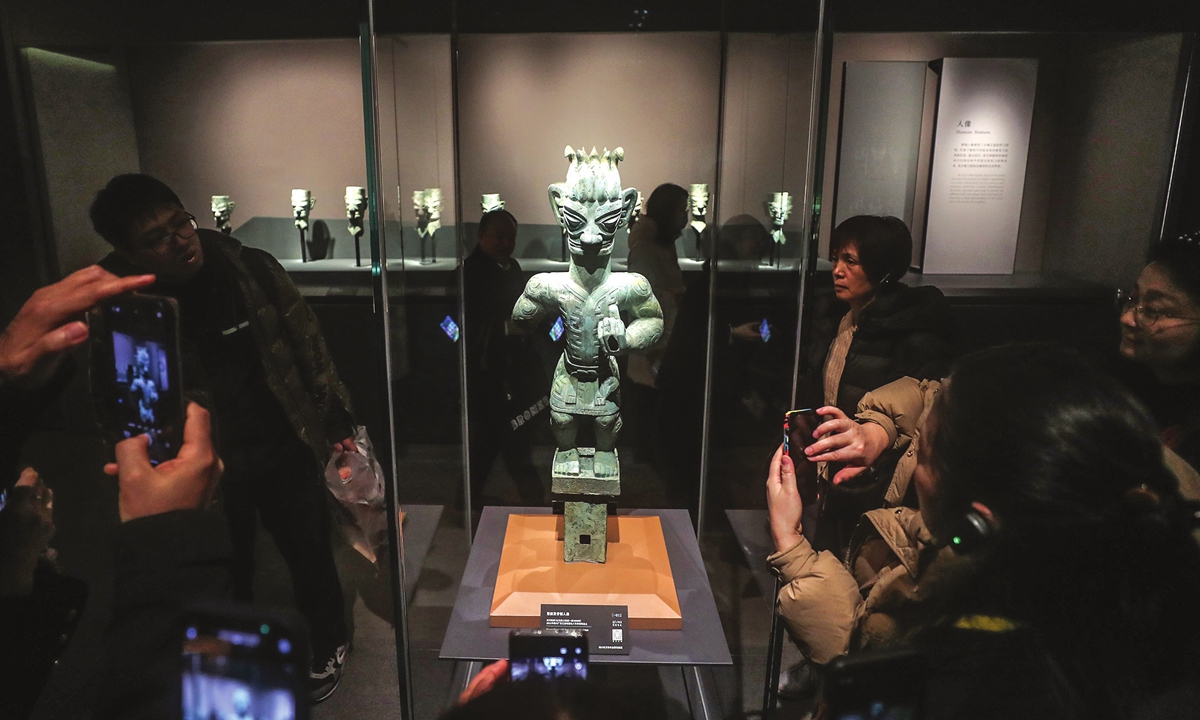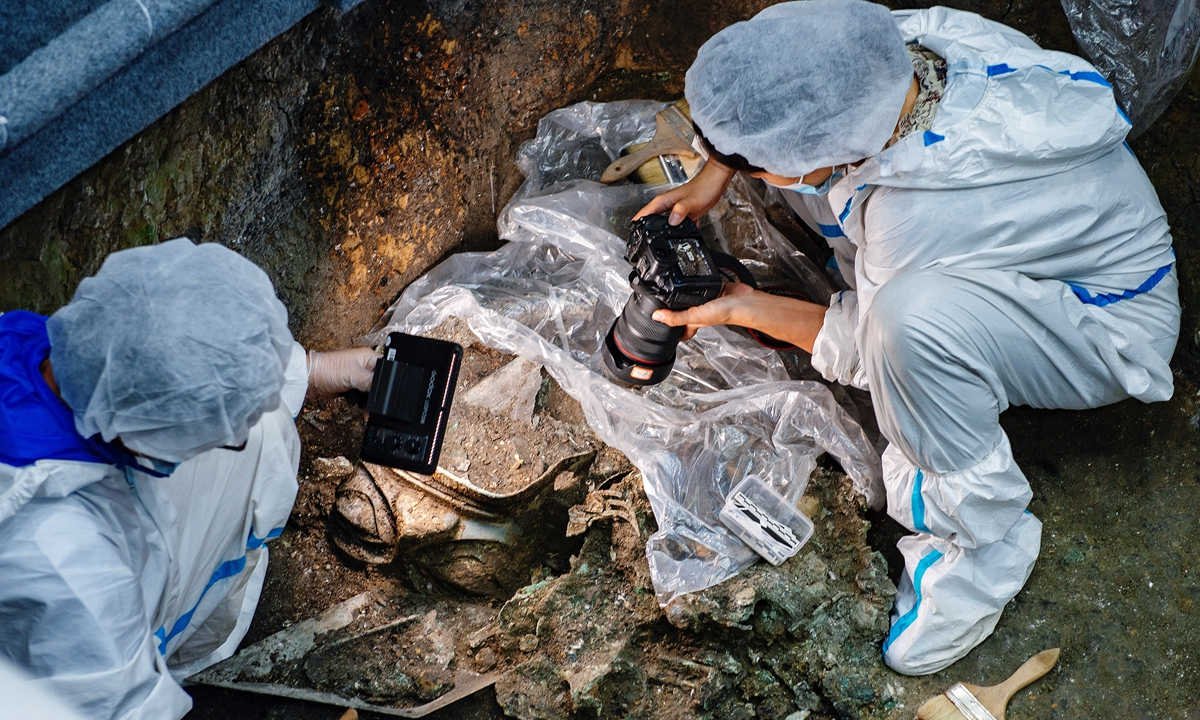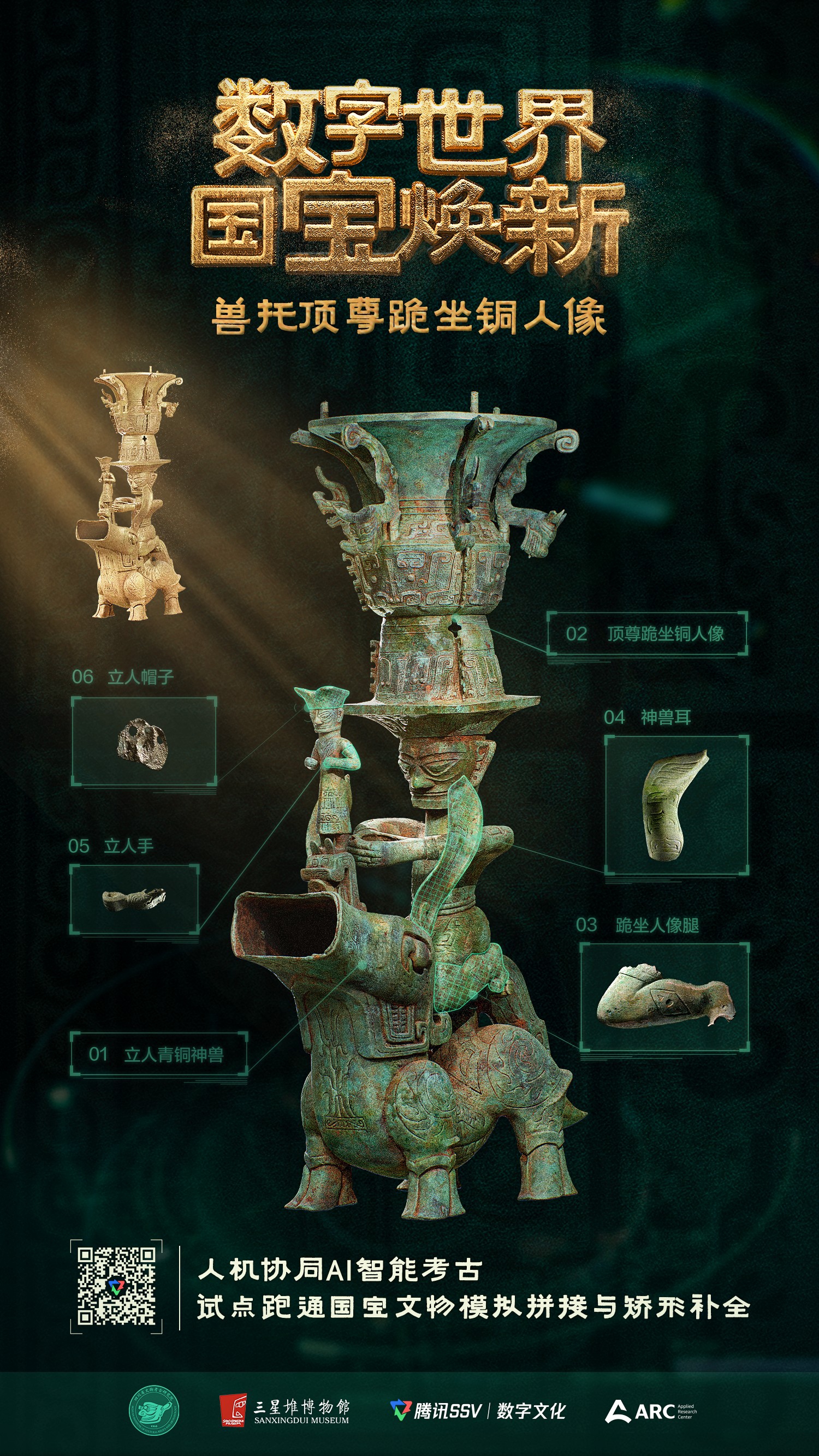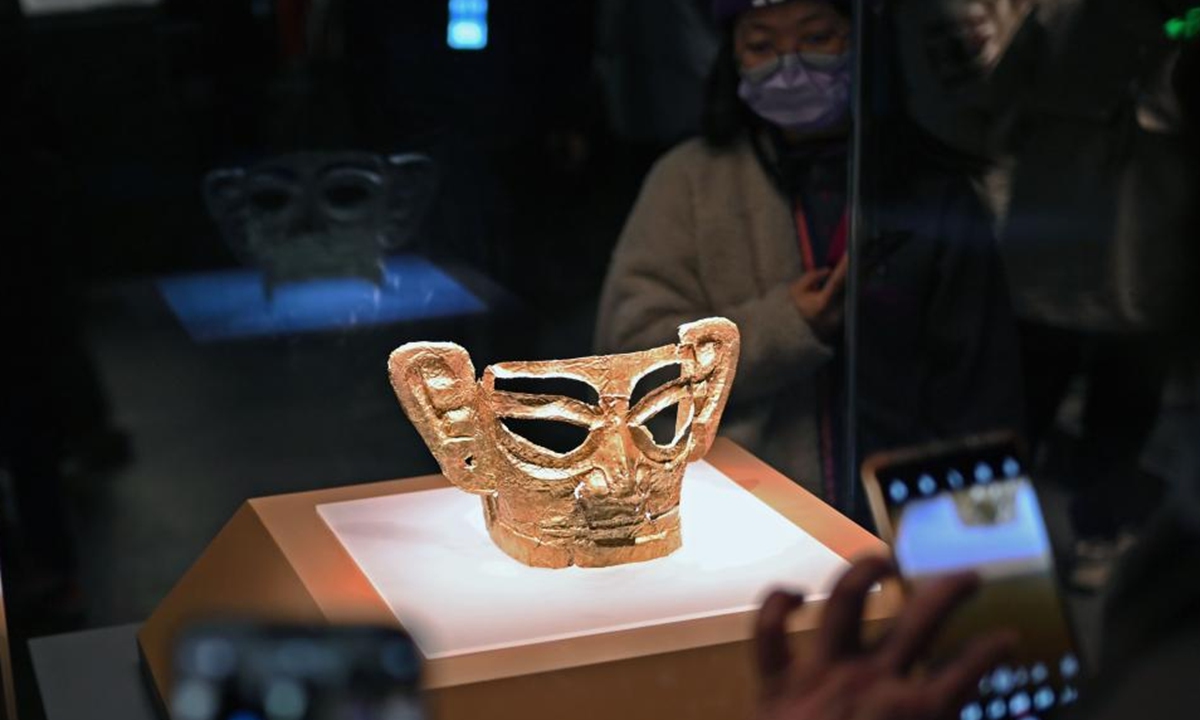IN-DEPTH / IN-DEPTH
AI technologies, tools help Chinese archaeologists restore cultural relics, secure deals in antique trading market

Visitors take pictures of a bronze figure statue from Sanxingdui Ruins at an exhibition in the Shanghai Museum on Febriuary 2, 2024. Photo: VCG
Editor's Note:
Big models, robots, intelligent manufacturing, autonomous driving... In recent years, AI (artificial intelligence) has frequently made headlines around the world as a hot topic of discussion. The emergence of generative AI programs has also created unemployment anxiety.
The development of technology has indeed brought challenges in various aspects such as in ethics and law. But at the same time, many experts advocate that humans should see technology as a tool created for the ultimate purpose of serving humanity, making life and work more efficient and comfortable.
In real life, AI has already permeated all aspects of human society, helping with scientific research in laboratories, assisting in the restoration of mysterious ancient scrolls at archaeological sites, and helping to find abducted children in the vast sea of humanity.
In light of this, the Global Times has launched the "AI empowers industry, improves people's livelihoods" series, showcasing the tremendous energy and broad prospects that AI brings to various industries.
This is the second installment in this series. In this story, experts in the archaeological field share how AI helps them unlock the secrets from thousands of years ago. Observers from the antique and jewelry trading market also explain why consumers can make more solid deals with the assistance of AI technology.

Experts excavate relics at the Sanxingdui Ruins site in Guanghan, Southwest China's Sichuan Province, on September 28, 2021. Photo: VCG
The current round of discoveries at the pits at the Sanxingdui Ruins site in Southwest China's Sichuan Province have revealed more than 17,000 cultural relics, with only over 4,800 relatively intact artifacts. Meanwhile, tens of thousands of cultural relics or specimens are also being excavated annually in other archaeological sites across the province. How are the less than 200 cultural relic restoration personnel in the province supposed to complete the related mountain of work?
In the past, they had no choice but to take on the work little by little as the "foolish old man" Yu Gong moved mountains in Chinese fairy tales. But now, they have a new tool - artificial intelligence (AI) - that can save them up to decades in time.
By using AI technology, the efficiency of restoration can be greatly improved. Through digital scanning and analysis of the damage to cultural relics, AI systems can simulate much better solutions, making restoration work more precise and efficient, Wang Chong, an associate research fellow from the Sichuan Provincial Cultural Relics and Archaeology Research Institute (Archaeology of Sichuan), told the Global Times.
Unlock thousand-years-old secrets
Originally discovered in the late 1920s, the Sanxingdui Ruins have been dubbed one of the world's greatest archaeological finds of the 20th century.
Located in Guanghan, around 60 kilometers from Sichuan's provincial capital Chengdu, the ruins covering an area of 12 square kilometers are believed to be the remnants of the Shu Kingdom that existed at least 4,800 years ago and lasted for more than 2,000 years.
After the discovery of a large number of precious cultural relics in sacrificial pits No.1 and No.2 in 1986, Archaeology of Sichuan kicked off a new round of archaeological excavation of pits No.3-8 in 2020.
As the excavation and cleaning work gradually progressed at the pits, archaeological experts discovered that a large, bronze mythical creature extracted from pit No.8 could probably be combined with a kneeling bronze figure unearthed from pit No.3 as the mythical beast has two vertebral bodies on its back, and the bronze figure has mortise and tenon joints on the knees and soles of the feet of similar sizes.
However, experts found difficulties in proving their suspicions as these two artifacts are very tall, standing at more than two meters, and fragile. Conducting a splicing experiment risked causing irreversible damage to the artifacts.
After finishing some preliminary research and assessment, the Archaeology of Sichuan team turned to AI for a solution to this problem together with the Tencent Digital Culture Laboratory and the company's Applied Research Center Lab in March 2023.
The joint team extracted geometric feature information from the contact surfaces between the mythical beast and the figure, calculated the feature similarity to obtain splicing matching data indicators, and conducted overall force analysis to determine the balance of the splicing combination.
Through quantitative data verification, the feasibility and reasonable splicing method of the combination of the two artifacts were confirmed, digitally recreating the original glory of the statue.
What we mainly do with AI technologies is scanning the relics and sending the three-dimensional data to the computer and letting the computer carry out "automatic stitching." Manual assistance is still necessary at this current stage, so we call it a man-machine coordination mode, Wang said.
AI is also being used in analyzing artifact diseases, according to Wang. With AI algorithms based on geometry and physical engines, archaeological experts measure and analyze crack lengths, geometric radii of different cross-sections, matching degrees at different splicing positions, overall posture, and force situations of artifacts. This provides quantitative support for experts in analyzing artifact deterioration and protection and explores the intersection of archaeological research and computer science.
In the long run, the joint project team plans to develop more AI-assisted intelligent archaeological tools in artifact splicing, simulated restoration and archaeological drawing, and gradually promote these tools from Sanxingdui to the whole archaeological industry in China, improving the efficiency of archaeological research in the country, according to Wang.

Photo: Courtesy of the Sichuan Provincial Cultural Relics and Archaeology Research Institute
Assure solid deals
In the market of antique identification and trading, AI is also playing an important role in helping experts to retrieve lost artifacts and guarantee buyers get what they pay for.
According to media reports, AI has already been used by Chinese experts in identifying ancient script from Xixia (or Tangut) 1038-1227, Oracle bone script, and the lost Dunhuang scriptures. An AI technology developed by research institutions at Ningxia University to identify Xixia script was reported to have achieved a high recognition rate.
The Global Times found that a luxury product identification app, Turing, based on AI technologies developed by a research team from Tsinghua University is available on Apple Store. According to the app's description page, it can not only be used to identify antiques and jewelry, but also luxury clothing, watches and bags, and even wines and precious Chinese medicines.
If a user feels like using quick AI identification, all he or she needs to do is upload some photos. On Tuesday morning alone, the app completed more than one million identification services, according to the data showed on the app's home page.
Taking jade as an example, users only need to upload some photos, then the app automatically extracts and inputs information such as the structure, color, luster, fluorescence, surface texture, and refractive index of the product and compares it to millions of jade images in its database to determine authenticity and category, Tang Pingzhong, a main developer of the app, told Beijing Business Today.
The standard for judging the quality of the application of AI in the future is the automation level of industries with a large workforce and high skill requirements. In the field of luxury product identification, the role of AI is similar to that of human appraisers, quality inspectors, and pawnshop owners, which covers a large group of people whose skills are irreplaceable.
Tang predicted that the total order of the entire AI identification industry would exceed one billion by 2026, with a high-margin market size of 5 to 10 billion yuan ($1.38 billion).
AI is also expected to help regulate the large but mixed market.
Regarding antique appraisal, in the past, manual appraisal was the main method, with experienced professionals determining authenticity, which is relatively subjective. By applying AI technology, a standard approach probably can be provided for antique appraisal, Zhang Yi, CEO of iiMedia Research Institute, told Beijing Business Today.
"AI appraisal can efficiently solve problems in the jade market such as 'mismatched goods' and 'fraud risks for both buyers and sellers,' bringing information symmetry and efficient matching of transactions for both parties. We hope to help combat dishonest anchors and jade dealers who try to exploit legal loopholes," Tang said.
To some other industry observers, the advantage of AI appraisal lies in the tamper-proof nature of the traceability certificate. Based on the uniqueness of the certificate chain technology, it can ensure the accuracy of identifying details in calligraphy and paintings, while also improving the efficiency of basic identification. In other words, AI appraisal provides a powerful supplement and support based on scientific judgment.

Visitors look at an exhibit during the exhibition of "Stars over China: The Ancient Shu Civilization of Sanxingdui and Jinsha" in Shanghai Museum, Shanghai, east China, Feb. 15, 2024. (Xinhua/Liu Ying)
Bridge intelligent future
Although AI has various advantages in visual and image recognition, the identification of cultural relics and antiques still heavily relies on the experience and intuition of researchers at the current stage.
"The application of AI in archaeology still faces some difficulties. For example, digital scanning modeling is costly and AI requires a large amount of data samples to train and learn if we want it to become smarter," Wang Chong said.
But AI is still definitely a direction worth exploring, experts and industry observers have agreed.
For example, in archeology, the methods for detecting the age of ancient books and paintings mainly include infrared material analysis, carbon-14 dating, and gas chromatography separation techniques. The most reliable dating technique is the "carbon-14 dating method." However, this method requires a large sample size, which can cause damage to precious ancient paper books.
However, AI focuses on the painting and calligraphy style of ancient texts rather than the material. The unique characteristics of each painter or calligrapher's brushwork, such as the shape and curvature of the strokes and the speed of the brush, among other features, can be identified by AI when there is a sufficient amount of data on their works, becoming the key to distinguishing authenticity, experts noted.
In the future, AI will penetrate various aspects of archaeological surveys, excavations, material organization, data analyses, and even theses writing, according to Gao Xing, a research fellow at the Institute of Vertebrate Paleontology and Paleoanthropology, Chinese Academy of Sciences.
It can assist and guide humans in formulating survey and excavation plans, material classification, fragment assembly, and artifact restoration. It can also reduce the demand for field archaeological excavations (including underwater archaeology), so that more and more precious cultural heritage may be preserved underground or underwater in their original state, Gao noted.
More importantly, with intelligent technologies, more and more Chinese archaeological achievements can be connected and shared by the international academic community, according to Gao.
As to the application of AI in helping normal people identify products, Tang and his team have also been drafting industry standards together with related associations in order to protect consumers' rights.
